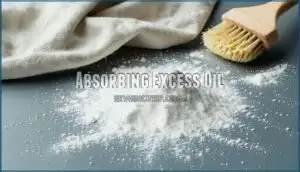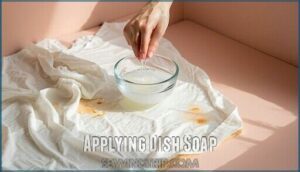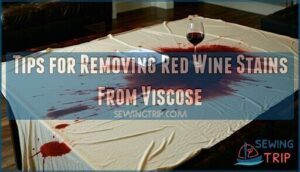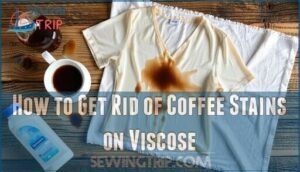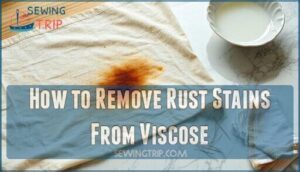This site is supported by our readers. We may earn a commission, at no cost to you, if you purchase through links.

Start by gently blotting (never rubbing) the stain with a clean cloth, then treat it with cold water and mild detergent.
For stubborn spots, try a diluted white vinegar solution or oxygen-based stain remover, always working from the outside of the stain inward. The secret sauce? Speed and gentleness—viscose forgives quick action but punishes aggressive scrubbing.
From wine spills to makeup mishaps, each stain type has its own playbook for victory.
Table Of Contents
- Key Takeaways
- How to Remove Water Stains From Viscose
- Removing Oil and Grease Stains From Viscose
- Tips for Removing Red Wine Stains From Viscose
- Removing Lipstick Stains From Viscose
- How to Get Rid of Coffee Stains on Viscose
- Removing Deodorant Stains From Viscose
- Tips for Removing Perfume Stains From Viscose
- How to Remove Rust Stains From Viscose
- Cleaning Stains on Viscose Rugs or Carpets
- Best Stain Remover Options for Viscose
- Frequently Asked Questions (FAQs)
- Conclusion
Key Takeaways
- Act fast and blot gently – Speed matters more than force when dealing with viscose stains, so immediately blot (never rub) with a clean cloth to prevent the stain from setting permanently.
- Use cold water and mild solutions – Always stick to cold water, mild detergent, or diluted white vinegar, since heat and harsh chemicals can damage viscose’s delicate fibers.
- Work from outside edges inward – This blotting technique prevents the stain from spreading and keeps the mess contained, while protecting the fabric’s integrity.
- Air dry flat after treatment – Never wring, twist, or use a dryer, since viscose weakens when wet; instead, gently squeeze out excess water and lay flat to maintain the garment’s shape.
How to Remove Water Stains From Viscose
Water stains on viscose might seem scary, but they’re actually some of the easiest marks to tackle if you act quickly.
You’ll want to start with gentle blotting and a simple vinegar solution to restore your fabric without causing damage.
Blotting Technique
When you spot a water stain on your viscose fabric, think of yourself as a detective gathering evidence—gently, of course.
Start by grabbing a clean, white cotton cloth or paper towel as your blotting materials. The key to viscose stain removal lies in pressure control: use light, dabbing motions instead of aggressive rubbing that’ll damage those delicate fibers.
Work from the stain’s outer edges toward the center to prevent stain spreading—this blotting direction keeps the mess contained. Remember, viscose fabric care requires patience, so take your time with these stain removal methods for best results.
To maintain the fabric’s integrity, remember that hand washing is recommended for best results.
Using Vinegar Solution
When blotting isn’t enough, a vinegar solution becomes your secret weapon for viscose stain removal.
Mix equal parts white vinegar and cool water—this vinegar dilution ratio maximizes stain type efficacy without overwhelming delicate fibers.
Gently dab the solution onto water marks using application techniques that won’t damage viscose colorfastness.
Let it sit for ten minutes, then rinse with cold water.
The acetic acid works like magic, breaking down mineral deposits that cause those pesky spots. Don’t worry about neutralizing vinegar odor—it’ll disappear as your viscose fabric care routine continues with proper removing viscose stains methods.
Drying and Reshaping
After absorbing excess water, reshaping becomes your fabric’s lifeline—preventing permanent wrinkles and maintaining viscose’s natural drape.
Gentle manipulation during air drying preserves the fiber structure while avoiding heat damage that could spell disaster for your garment.
- Reshape immediately after blotting to prevent fabric stretching and maintain original silhouette
- Air-dry flat on towels rather than hanging to avoid gravitational distortion of wet fibers
- Use padded hangers only for structured pieces that won’t lose shape under their own weight
- Avoid direct sunlight which can cause uneven drying and potential color fading
- Steam iron on reverse side once completely dry for professional-looking results without heat damage
Removing Oil and Grease Stains From Viscose
Oil and grease stains on viscose can seem impossible, but don’t panic—quick action makes all the difference.
The key is absorbing the excess oil first, then treating the stain gently without damaging the delicate fibers.
Absorbing Excess Oil
When dealing with oil stains on viscose, time isn’t on your side—act fast.
Sprinkle baby powder or cornstarch generously over the fresh stain, creating a powder application that’ll work like a sponge.
This dwell time of one to two hours lets the powder absorb the oil completely.
Then, use a gentle brushing technique with a soft brush to remove residue removal particles.
Remember, blotting beats rubbing every time for viscose stain removal and stain prevention.
Applying Dish Soap
Once you’ve absorbed the excess oil, dish soap becomes your secret weapon for viscose stain removal. This gentle yet effective approach works wonders on delicate fibers without causing damage.
Here’s how to master dish soap application for cleaning viscose clothing:
- Choose mild soap types – Select gentle, dye-free dish soap for ideal stain lifting without harsh chemicals
- Create proper dish soap dilution – Mix one part soap with two parts cold water for safe gentle application
- Apply with care – Dab the solution onto the stain using light circular motions, avoiding aggressive rubbing
Let the soap work its magic for 5-10 minutes before moving to residue removal. Using gentle cleaning solutions is vital for delicate fabrics. This patient approach guarantees thorough viscose stain removal while protecting those precious fibers.
Washing and Drying
After treating the oil stain with dish soap, it’s time to tackle the washing and drying process—arguably the most vital step in viscose stain removal. Hand-washing viscose requires a gentle touch and cold water to prevent fiber damage.
Use a mild liquid detergent, swishing the garment gently without aggressive scrubbing that could cause pilling or stretching. When laundering viscose, think of it like caring for a delicate flower—too much force and you’ll ruin its beauty.
Rinse thoroughly until all soap disappears, then comes the tricky part: removing excess water. Never wring or twist viscose; instead, gently squeeze and roll it in a clean towel.
Drying techniques matter enormously for avoiding shrinkage. Always air dry viscose flat on a towel or hang it carefully to maintain its natural drape. Skip the dryer entirely—heat is viscose’s enemy.
For ironing viscose, use medium heat with a pressing cloth while slightly damp. Consider professional cleaning for valuable garments.
Tips for Removing Red Wine Stains From Viscose
Red wine spills on viscose don’t have to spell disaster if you act fast and follow the right steps.
The key is immediate action combined with gentle techniques that won’t damage this delicate fabric while lifting that stubborn burgundy stain, which requires gentle techniques.
Blotting and Absorbing
When red wine meets your viscose fabric, think of yourself as a first responder—immediate action prevents a minor spill from becoming a permanent reminder.
Your absorbent allies are essential for effective viscose stain removal tips.
Here’s your blotting game plan:
- Use white paper towels or clean cloth to avoid color transfer
- Apply gentle pressure without rubbing to lift wine upward
- Work from outside edges inward to prevent stain spreading
- Change blotting materials frequently as they absorb wine
- Layer absorbent materials for maximum wine extraction
Keep dabbing with fresh sections until no more wine transfers to your blotting materials.
The key is patience—let the absorbent layering do the heavy lifting while you maintain that gentle pressure application.
Using Salt or Baking Soda
When blotting doesn’t completely lift that stubborn red wine, salt becomes your secret weapon.
Sprinkle salt generously over the stain while it’s still wet – its salt absorbency works like a magnet, drawing wine from viscose fibers.
For set-in stains, create a baking soda paste with water, applying gently to avoid fiber damage.
These gentle abrasives provide stain neutralization without harsh chemicals, plus they tackle odor removal too.
Think of it as giving your viscose a spa treatment – these natural viscose stain removal methods restore your fabric’s beauty without the drama.
You can even find gourmet flavored options for culinary use.
Washing and Treating The Stain
After setting with salt or baking soda, rinse the viscose with cold water to remove wine residue.
Apply a gentle detergent designed for delicate fabrics, working it in with light finger pressure. Choose lukewarm water temperature for your pre-wash treatment, then hand-wash using minimal agitation.
These viscose stain removal methods protect fibers while ensuring effective cleaning techniques for complete stain removal. They provide a way to clean the fabric gently, making sure that the delicate fabrics are not damaged during the process.
Removing Lipstick Stains From Viscose
You’ve probably discovered lipstick stains the hard way—they’re stubborn little troublemakers that love to cling to delicate fabrics like viscose.
Don’t panic though, because with the right approach and a bit of patience, you can tackle these waxy culprits without damaging your favorite garment, and by doing so, you’ll be able to handle these stubborn little problems.
Scraping Off Excess Lipstick
When lipstick meets your favorite viscose blouse, don’t panic—quick action prevents a fashion disaster.
First, gently scrape off excess lipstick using a dull knife or spoon, working from the outside in to avoid spreading. Think of it like removing frosting from cake—patience beats pressure every time.
Your lipstick removal tools arsenal should include:
- A plastic spoon for gentle scraping without fabric damage prevention concerns
- Clean white cloth for blotting without color transfer
- Mild dish soap as your go-to pre-treatment option
- Cold water to keep the stain from setting permanently
Remember, viscose stain removal requires a light touch. Heavy-handed scraping pushes pigment deeper into fibers, making your job harder. Professional assistance becomes necessary when aggressive rubbing has already occurred, so resist the urge to attack the stain.
Applying Dishwashing Liquid
When lipstick won’t budge, dish soap becomes your fabric’s best friend.
Follow these Application Methods for effective viscose stain removal:
- Apply three drops of clear dish soap directly onto the lipstick stain
- Gently massage with fingertips using circular motions for ideal penetration
- Allow the soap to work its magic for two minutes
- Blot with a clean, damp cloth to lift dissolved oils
- Rinse thoroughly with cool water for complete Residue Removal
This gentle approach tackles grease stains while maintaining Fabric Safety. The right Dilution Ratios and technique make viscose stain solutions work effectively against stubborn Stain Types.
Laundering The Fabric
Once you’ve treated the lipstick stain with dishwashing liquid, it’s time for hand-washing viscose using cold water and mild detergent.
Gently swish the fabric without wringing or twisting. After thorough rinsing, squeeze out excess water carefully and roll in a clean towel.
To prevent damage, remember to keep in mind viscose fabric care. For proper drying techniques, lay flat on a padded surface to maintain shape and prevent stretching during air drying, which is crucial for viscose fabric.
How to Get Rid of Coffee Stains on Viscose
Coffee spills happen to everyone, and when they hit your favorite viscose garment, don’t panic. Immediate blotting is your best friend here—grab a clean cloth and dab (never rub) the spill to lift about 80% of the liquid before it sets into those delicate fibers.
Start your viscose stain removal process with a cold water rinse from the back of the fabric if possible. This pushes coffee particles outward rather than deeper into the material. Next, create a vinegar solution using one part white vinegar to two parts cold water—this mixture breaks down coffee’s organic compounds without damaging viscose.
For stubborn coffee stains, pre-treat with mild liquid detergent before applying your vinegar mixture. Avoid enzyme treatment on viscose, as these can weaken the fibers. If home viscose stain treatment doesn’t work after two attempts, consider professional cleaning to preserve your garment’s integrity and prevent permanent damage.
Viscose’s delicate nature means you should consider gentle hand-washing for stain removal.
- Blot immediately with clean, white cloth to prevent spreading
- Use cold water only—heat sets coffee stains permanently
- Apply vinegar solution gently with dabbing motions
- Air dry flat to prevent stretching or warping
- Seek professional help for persistent stains after two attempts
Removing Deodorant Stains From Viscose
Deodorant stains on your viscose clothes don’t have to spell disaster – they’re actually easier to tackle than you might think.
With the right approach using rubbing alcohol and gentle pre-treatment, you can restore your favorite viscose pieces without damaging those delicate fibers.
Using Rubbing Alcohol
Tackling deodorant stains with rubbing alcohol requires a gentle touch, but it’s surprisingly effective for viscose stain removal.
Dilute the rubbing alcohol with two parts water—this safety precaution prevents fiber damage while maintaining effectiveness.
Soak a cotton pad and hold it against the stain, keeping it moist during treatment. The alcohol application dissolves both deodorant residue and antiperspirant components, making this stain treatment ideal for various stain types.
Always dab, never scrub, to protect delicate viscose fibers.
Remember to check the fabric’s colorfastness before applying any cleaning agent.
Test alternative solvents on hidden areas first.
Pre-treating With Stain Remover
When deodorant marks turn your favorite viscose top into a fashion disaster, smart pretreating becomes your secret weapon.
Grab a stain remover labeled "safe for delicates" and apply it directly to the affected area—think of it as giving those stubborn marks a gentle talking-to before the main event.
For viscose stain removal, enzyme pre-soaking works wonders, but skip protease-based products that’ll weaken fibers.
Try vinegar dilution (equal parts water and white vinegar) for natural stain treatment, or create a paste with baking soda and water for powder absorption.
Always use gentle dabbing motions rather than aggressive rubbing to protect delicate viscose fibers during alcohol application.
Laundering and Drying
Once you’ve pre-treated the stain, gentle washing becomes your best friend for viscose care.
Use cold water and your washing machine’s delicate cycle, keeping the spin speed under 600 rpm to prevent fiber damage.
After laundering, resist the urge to wring or twist—instead, gently squeeze out excess water like you’re handling a delicate flower.
Air-dry methods work wonders here; lay your garment flat on a clean towel or mesh rack, reshaping while damp to maintain its original form.
This shape preservation technique prevents those stubborn wrinkles that love viscose.
Skip the dryer entirely—heat’s the enemy when avoiding shrinkage.
For wrinkles later, ironing viscose requires low heat and a pressing cloth for protection.
Tips for Removing Perfume Stains From Viscose
Perfume stains on viscose can set quickly, so you’ll want to act fast before the oils and alcohol penetrate the fibers.
The good news is that with some dish soap and gentle technique, you can tackle these fragrant mishaps without damaging your delicate fabric, using a method that requires delicate fabric care.
Pre-treating With Dish Soap
Several drops of mild dish soap mixed with cold water create the perfect dilution ratios for viscose stain removal—think one teaspoon per cup of water.
This gentle application method breaks down perfume’s oily components without damaging delicate fibers. Dab the solution onto the stain using a clean cloth, working from outside edges inward to prevent spreading.
Let it sit for 10-15 minutes, allowing the soap to penetrate and lift stubborn residues. Different soap types work well, but avoid harsh detergents that compromise stain compatibility with viscose.
Viscose is known for its softness, but improper washing can cause damage. This pretreating step is your secret weapon against perfume mishaps on precious garments, utilizing a gentle method to remove perfume’s oily components and stubborn residues.
Washing and Reshaping
After washing with gentle detergents and cold water, your viscose needs careful handling.
Press out excess moisture with a clean towel—never wring or twist.
Here’s your air drying game plan:
- Lay flat on a towel to prevent stretching
- Gently reshape while damp for best results
- Smooth out wrinkles with your hands
- Keep away from heat sources to avoid shrinkage
Handwashing with mild detergent protects delicate fibers, while proper reshaping techniques guarantee your garment returns to its original form beautifully.
How to Remove Rust Stains From Viscose
Rust stains on viscose can look intimidating, but they’re actually easier to tackle than you might think.
You’ll need to act quickly and use the right approach to avoid damaging this delicate fabric while getting those stubborn orange-brown marks out for good, which can be considered a delicate task.
Applying Lemon Juice or Vinegar
Lemon juice’s acidic pH levels work like nature’s rust-buster for viscose stain removal. Apply undiluted lemon juice or white vinegar directly onto the stain, letting fabric sensitivity guide your application techniques.
For stubborn rust, try these dilution ratios:
- Mix equal parts vinegar and water for gentle treatment
- Create lemon juice paste with salt for targeted action
- Allow 30-minute dwell time before thorough rinsing
Remember, stain type matters—rust responds beautifully to acids, but always test first on hidden areas. To prevent future occurrences, consider that humidity accelerates rust on nearby sewing machines, which could transfer to fabric.
Using Commercial Rust Remover
Commercial rust removers pack serious punch against severe rust stains on viscose, but they’re not foolproof.
Choose oxalic acid-based products specifically designed for delicate fabrics—think Magica Rust Remover Gel over harsh alternatives.
Always spot-test first, because Rust Remover Risks include potential color fading or fiber damage.
Follow Remover Application Tips strictly: apply sparingly, never exceed recommended dwell time, and work in well-ventilated areas.
Neutralizing Remover Residue through thorough rinsing prevents long-term fabric breakdown.
When comparing brands, prioritize those labeled "safe for delicates" over industrial-strength options for best stain removal results.
Effective rust remover gels can make a significant difference in the outcome of the stain removal process.
Cleaning Stains on Viscose Rugs or Carpets
Viscose rugs and carpets need special care since they can’t handle traditional wet cleaning methods like other fabrics.
You’ll want to stick with dry cleaning solvents or professional services to avoid damaging the delicate fibers and causing permanent shrinkage or distortion, which can be a result of using incorrect methods on delicate fibers.
Using a Dry Cleaning Solvent
Dry cleaning solvents work like magic on stubborn viscose rug stains, but they’re not child’s play.
Start by testing your chosen solvent on a hidden corner—trust me, you’ll thank yourself later. Apply the dry cleaning solution sparingly using a clean white cloth, dabbing gently from the stain’s outer edge inward.
This prevents spreading and protects the delicate viscose fibers from damage. Remember, viscose carpets hate moisture, so these Dry Cleaning Methods keep water out of the equation entirely.
Let the treated area air-dry completely before declaring victory. With proper Solvent Safety and gentle technique, your viscose rug will look fresh again.
Professional Cleaning Recommendations
When dry cleaning solvents can’t tackle stubborn stains, professional cleaning becomes your best bet.
Fabric care specialists possess specialized viscose stain removal techniques and cleaning solutions that protect delicate fibers while delivering superior results.
Professional services offer several advantages:
- Advanced equipment designed specifically for viscose maintenance and delicate handling
- Expertise in oxygenbased stain removers that won’t damage your rug’s structure
- Peace of mind knowing your investment receives proper care
These experts assess each stain individually, applying targeted stain prevention strategies to restore your rug’s original beauty safely.
Best Stain Remover Options for Viscose
In the context of choosing the right stain remover for viscose, you’ve got three solid options that won’t destroy your delicate fabric.
Each type works differently, so picking the right one depends on what kind of mess you’re dealing with, and understanding the differences is crucial for making an informed decision about the best option.
Oxygen-based Stain Removers
In the context of rescuing your favorite viscose pieces from stubborn stains, oxygen-based stain removers are your fabric’s best friend.
These gentle removers work like magic, releasing oxygen bubbles that lift stains without the harsh damage of chlorine bleach.
Here are your top oxygen bleach options for viscose stain removal effectively:
- OxiClean powder – Mix with water and soak for 1-6 hours to tackle coffee, wine, and grease stains
- Tide Ultra Oxi Powder – Contains sodium percarbonate that’s particularly effective on dye and grass stains in warm water
- Clean People’s Oxygen Brightener – Uses citric acid for color safe brightening without synthetic chemicals
- Molly’s Suds oxygen stain lifters – Expert-recommended fabric protector that won’t weaken delicate fibers
These oxygen-based stain removal products won’t cause yellowing or fabric breakdown like traditional bleach.
Always patch test first – your viscose will thank you later!
Enzyme-based Stain Removers
Enzyme cleaners work like tiny molecular scissors, breaking down stains that have bonded with your viscose fibers.
These bio removers excel at tackling protein-based messes—think blood, sweat, or that unfortunate pasta sauce incident.
Unlike harsh chemicals, gentle cleaners with stain enzymes respect viscose’s delicate nature while getting the job done.
Products like Zout and Puracy use multiple enzymes for thorough protein removal, making your viscose stain removal routine surprisingly effective, and these enzyme-based stain removers are your viscose stain guide’s best friend.
They offer powerful yet safe cleaning for delicate fabrics, making them an ideal choice for cleaning viscose fibers, and are capable of thorough protein removal.
Natural DIY Stain Removers
You don’t need fancy products when your pantry holds powerful stain-fighting allies.
White vinegar mixed 1:1 with water tackles most viscose stains—just patch test first!
Baking soda paste with dish soap handles greasy messes, while castile soap offers gentle cleaning for everyday marks.
These natural DIY stain removers prove that herbal remedies and simple ingredients often outperform commercial products, giving you viscose stain removal naturally without harsh chemicals.
Frequently Asked Questions (FAQs)
How do you remove stains from viscose fabric?
Time is of the essence when tackling viscose stains.
Blot immediately with cold water—never rub.
Use mild detergent or white vinegar solution, working from stain edges inward.
Air-dry flat afterward, and remember Time is crucial in this process.
How do you remove water stains from viscose?
Water stains on viscose happen when moisture dries unevenly, leaving mineral deposits behind.
Gently dab the area with distilled water using a clean cloth, then air-dry flat to prevent new rings from forming, focusing on the complete concepts of stain removal and prevention.
How do you wash viscose fabric?
Hand-wash viscose gently using cold water and mild detergent. Swish softly, don’t wring or twist. Rinse thoroughly, squeeze out excess water, then air-dry flat to prevent stretching and damage.
How to remove water from viscose clothes?
Viscose fabric weakens by 50% when wet, making water removal essential.
Gently squeeze—don’t wring—excess water out.
Roll the garment in a clean towel to absorb moisture, then air-dry flat to prevent stretching.
How do you remove water stains from a viscose couch?
Blot water stains immediately with a clean, white cloth, working from edges inward. Mix equal parts white vinegar and cold water, then gently dab the stained area. Air-dry flat completely.
How do you clean a viscose garment?
Gentle hands make light work—treat your viscose like delicate silk.
Hand-wash in cold water with mild detergent, never wring or twist, then air-dry flat to preserve its soft, springy texture.
Does vinegar damage viscose?
No, white vinegar won’t damage viscose when diluted 1:1 with water. You’ll actually find it’s quite gentle and effective for light organic stains. Just test on a hidden area first.
How do you clean 100% viscose?
Hand-wash carefully with cold water and mild detergent. Gently squeeze—never wring or twist. Roll in a towel, then air-dry flat to prevent shrinkage and damage.
Can I machine wash viscose fabric safely?
Machine washing viscose isn’t recommended since it weakens when wet and can shrink, lose shape, or get damaged.
Stick with gentle hand washing in cold water—your favorite viscose pieces will thank you for the extra care!
How to prevent viscose from shrinking completely?
Always use cold water and avoid machine washing. Hand wash gently with mild detergent, never wring or twist the fabric, and air dry flat to prevent shrinking completely.
Conclusion
Mastering how to get stains out of viscose doesn’t require a degree in fabric forensics—just patience and the right approach.
Remember, speed beats strength every time with this finicky fabric.
Whether you’re battling wine spills, makeup mishaps, or mystery spots, gentle blotting and cold water are your best friends.
Keep these techniques handy, and you’ll transform from viscose victim to stain-fighting champion in no time.
- https://en.wikipedia.org/wiki/Viscose
- https://buy.geni.us/Proxy.ashx?tsid=107655&track=homesandgardens-us-7967366604803888393&GR_URL=https%3A%2F%2Fwww.walmart.com%2Fip%2FMolly-s-Suds-Oxygen-Whitener-Powerful-Bleach-Alternative-Chlorine-Free-Color-Safe-Brightens-Whites-Removes-Stains-Pure-Lemon-Essential-Oil-79-oz%2F949699284
- https://vipcleanersdelivery.com/about-us/
- https://site.extension.uga.edu/textiles/care/stain-removal/remove-stains-from-antiperspirant-deodorant/
- https://www.bhg.com/how-to-get-deodorant-stains-out-8636186

